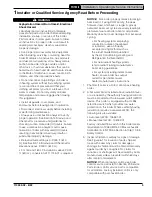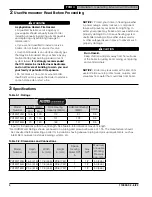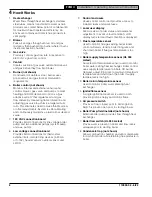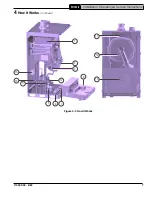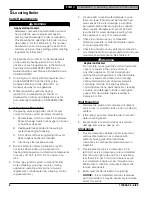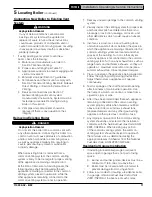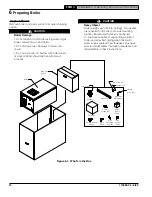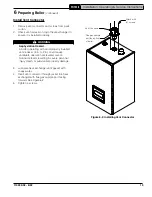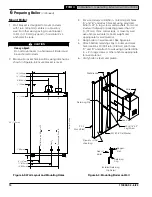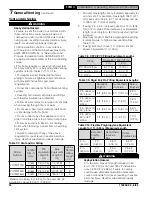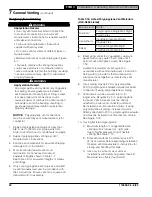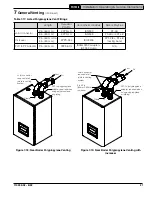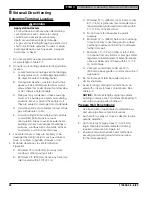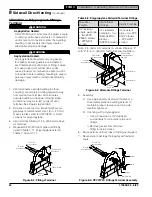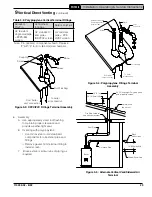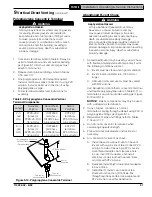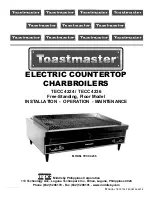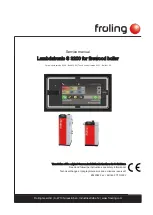
17
110332-02 - 6/22
PHTM II
Installation, Operating & Service Instructions
7
General Venting
(continued)
CPVC/PVC Venting
WARNING
Asphyxiation Hazard.
• Use only vent materials, primer, and cement
listed in Table 7-11 to make vent connections.
• Use of cellular core PVC (ASTM F891), cellular
core CPVC, or Radal® (polyphenolsulfone) in
venting systems is prohibited.
• PVC vent systems must include at least 30 in.
(760 mm) of CPVC pipe and one CPVC elbow
between boiler and PVC vent piping.
• CPVC is required within any interior space
where air cannot circulate freely, including a
vertical or horizontal chase, inside a stud wall, in
a closet, and through wall penetrations.
• Maintain clearances to vent piping per Figure
5-1.
• Failure to comply with venting instructions
could cause products of combustion and/or
carbon monoxide to enter the building, resulting
in severe personal injury, death or substantial
property damage.
!
NOTICE:
PVC may not be used to penetrate
combustible or non-combustible walls unless all
of the following conditions are met. If any of these
conditions cannot be met, use CPVC for wall
penetration. See Figure 7-14.
• Wall penetration is at least 66 in. (1.7 m) from
boiler measuring along vent pipe.
• Wall is less than or equal to 12 in. (305 mm)
thick.
• Air space shown in Figure 7-14 is maintained
around outside diameter of vent.
1. Slope CPVC/PVC vent pipe not less than 1/4 in.
per foot (21 mm per m) upwards from boiler to
vent terminal for condensate drainage.
2. Support CPVC/PVC pipe at intervals not
exceeding 4 ft. (1.2 m).
3. Be sure to use appropriate primer and cement
when joining CPVC to PVC. The following or
equivalent may be used to join CPVC to PVC:
A.
Primer: IPS P-70
B.
Cement: IPS 790
Material
Standard
Vent Pipe
CPVC, sched. 40 or 80 ASTM F441
PVC, sched. 40 or 80
ASTM D1785
PVC, DWV
ASTM D2665
Vent
Fittings
CPVC, sched. 80
ASTM F439
PVC, sched. 40
ASTM D2466
PVC, sched. 80
ASTM D2467
PVC, DWV
ASTM D2665
Primer/
Cement
CPVC
ASTM F493
PVC
ASTM D2564
Table 7-11: Listed CPVC/PVC Vent Materials
4. Work from boiler towards vent or air
termination. Do not exceed maximum
equivalent lengths shown in Table 7-7. See
Table 7-8 for equivalent lengths of elbows
and fittings.
5. Starting from the boiler, first 30 in. (760 mm)
of vent pipe and first elbow must be CPVC.
30 in. (760 mm) CPVC pipe may be cut at any
location and CPVC elbow installed between
two resulting CPVC pipes before transitioning to
PVC. PVC coupling may be used to join CPVC to
PVC vent piping. See Figure 7-12.
WARNING
Asphyxiation Hazard.
All CPVC/PVC vent joints must be glued. Failure
to comply could cause products of combustion
and/or carbon monoxide to enter the building,
resulting in severe personal injury, death or
substantial property damage.
!
NOTICE:
In Canada, CPVC and PVC vent pipe,
fittings, and cement/primer must be ULC-S636
listed.
5. Example equivalent length calculation for 2 in.
vent:
A. 1 ft. CPVC straight pipe =1 eq ft.
B. 90° CPVC short elbow = 6 eq ft.
C. 1.5 ft. CPVC straight pipe=1.5 eq ft.
D. Coupling = 0 eq ft.
E. 10 ft. PVC straight pipe = 10 eq ft.
F. 90° PVC sanitary elbow = 2.6 eq ft.
G. 15 ft. PVC straight pipe = 15 eq ft.
H. PVC coupling (terminal) = 0 eq ft.
I. Total vent length = 36.1 eq ft.
(acceptable length per Table 7-7)
6. Listed Air Piping Materials
A. PVC/CPVC
B. Polypropylene
C. B-vent double wall vent (with joints and
seams sealed with RTV silicone)
7. Listed Vent Materials
A. CPVC/PVC - See Table 7-11
B. Polypropylene - See Table 7-16

